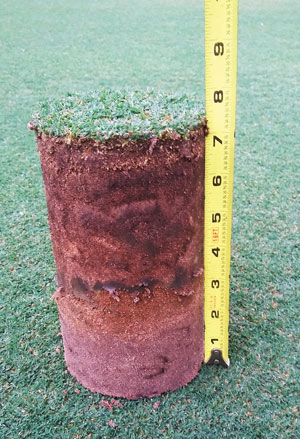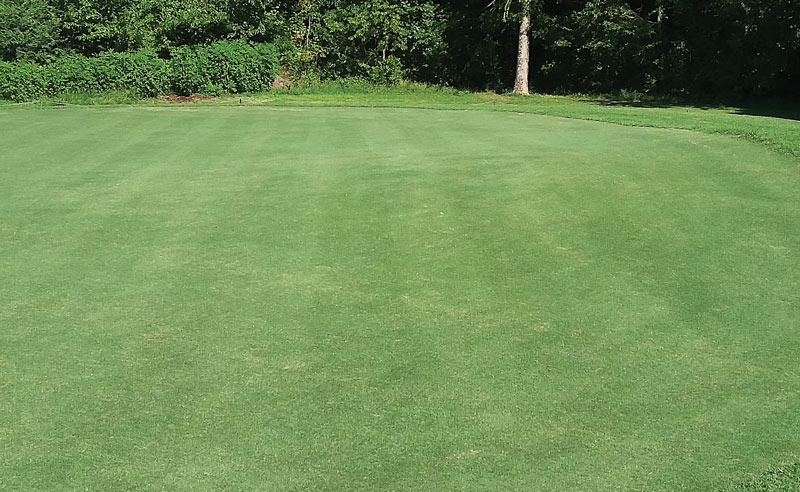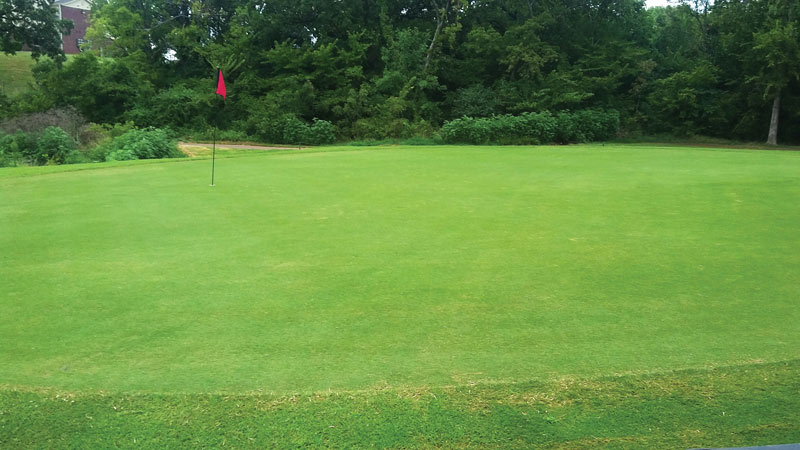
The 11th green at Silverhorn Golf Club gets some drill-and-fill TLC in late spring 2016. The plagued patch of turf gave superintendent Chris Sorrell, CGCS, a host of challenges during his time overseeing the 18-hole layout in Oklahoma City. Photos courtesy of Chris Sorrell
Some places are just bad. Sometimes, those places are golf course greens. And sometimes, those bad greens are the nexus of everything that can go wrong on a golf course, their loathsome presence resulting in disregard or negligence, which in turn makes the situation even more dire until a breaking point is reached and transformative change occurs.
Without a doubt, that was the case with the 11th green at Silverhorn Golf Club, an 18-hole public course in Oklahoma City that was open from 1991 until last December. This green must have been designed when the architect was in a particularly rotten mood. Or perhaps he simply put a green in a poor location with suboptimal growing conditions. Regardless, the tough times with No. 11 would both test my resolve to remain in the superintendent profession, and bring about what I consider some of my best professional work.

Anatomy of a flawed green
Picture this: As you approach the green on this par-5 hole, the fairway begins a gradual slope toward a creek that crosses directly in front of the putting surface. This creek forces players to drive to and from the green across bridges. Once on the green side, imagine three 30-foot-tall elms to the front right of the green and a massive oak to its left. Trees and scrub brush wrap around the green along the property line. In addition to this poor placement, the quality of the green’s build is shoddy. A general inconsistency exists in the greens mix, with distinct variations visible in the profile: fine sand here, course sand there, and occasional ribbons of clay.
With a bad soil mix, trees all around and proximity to a low creek bed, shade and lack of air movement become huge negative influences on turf health. Add to this the heat of a central Oklahoma summer plus fans that haven’t worked in years, and the prognosis for a bentgrass green becomes very dim. Whatever the cause of these conditions, the long and short of it was that Silverhorn No. 11 was designed to fail.
And fail it did. Constantly. Every year brought another 4,000 square feet of failure at the end of September. Some were more dramatic than others, but all were failures. A steady parade of superintendents made their way through the property, but no one was able to solve the problem. Assurances were made that the issue could be managed — it just required good moisture monitoring and an excellent fertility program. Yet even diligence in those areas was for naught.
Species swap
During my tenure at Silverhorn — from June 2013 to October 2017 — the same failure plagued me. Finally, in the summer of 2015, the whole course was hit by a particularly virulent pathogen, leaf blight, that rolled across the greens undeterred by fungicides. I’d sent a sample to Oklahoma State University’s Turfgrass Diagnostic Lab, and Nathan Walker, Ph.D., reported the lab had never seen the pathogen on a course in Oklahoma before. The damage from the disease was catastrophic.
The facility’s response to such desperate circumstances was to convert all the greens to Champion ultradwarf bermudagrass. The sprigs went down on the course on Aug. 21, 2015 — a very late date to undertake a conversion, but success for 2016 required the risk.
The results were nothing short of phenomenal. The 11th green grew in more rapidly, more densely and with better color than any other green on the course. Throughout the conversion process, No. 11 would consistently be about a week ahead of all the other greens. Prior to the switch, an experienced turf manager had told me that the worst greens on the course would become the best greens with Champion, and that prediction was spot-on. All the things that made No. 11 a death trap for bentgrass were irrelevant to Champion. The poor soil mix and restricted air movement made no difference. Because of bermudagrass’s shade intolerance, we’d removed the trees surrounding the green, eliminating the only element that would have presented a problem for the new sward.
From that point on, all was well, and the troublesome little green lived happily ever after. Except that wasn’t all.
Nematodes: A new (old) nemesis
During late spring of 2016, I noticed that No. 11 and some of the other greens didn’t seem to be thriving. While still in good shape, they lacked the vigor others were exhibiting. As the weeks wore on, No. 11 and its friends started to turn color. A chlorotic look took over the greens, signaling turf that was under stress. I could see no indication of a pathogen, and the temperature and weather were ideal for bermudagrass. By mid-June, the situation had once again become serious, and when samples I’d sent to the lab came back negative for pathogens, an Oklahoma State turfgrass pathologist suggested a nematode assay.
I had not considered nematodes as a possibility, as I’d been assured when I first interviewed for the Silverhorn job that there was no history of nematode activity. The 2016 test results dramatically contradicted that notion, however, as populations of ring nematodes on No. 11 were five times above the recommended threshold (212 per 100 cubic centimeters of soil, compared with the threshold of 40 per 100 cc).
In retrospect, that single bit of information may have been the most impactful of all regarding the poor turf performance on Silverhorn’s 11th green. I had noted in the past that poor rooting was common on the green, but had assumed it had something to do with all the other negative factors afflicting the area. I’d never considered that the roots were under attack by something, and during the conversion, with the plants pumped on high nutrient loads, the roots looked quite good. Previous pathogen tests had never revealed anything, and, of course, it couldn’t have been nematodes — there was no history of them!


Silverhorn No. 11 before (top) and after its nematode diagnosis and subsequent treatment regimen in 2016.
I try to take some comfort in the fact that even if I had discovered the nematode issue before the renovation, I still wouldn’t have had an effective way of treating it. It wasn’t until 2016 that a new nematicide was available to fill the void left by Nemacur’s removal from the market. Interim products offered only a wish and a prayer of control. With all the obstacles already facing No. 11, I doubt one of those remedies would have made much difference.
Following the nematode revelation, No. 11 and some other greens were started on a Nimitz nematicide program, and the tide turned. In a matter of three weeks, No. 11 was looking good and performing wonderfully.
Playbook for on-course quandaries
For a superintendent who’s dealing with a difficult green, my best advice is to test and track. A turf log that contains observations and relevant information is a powerful tool. When a problem pops up on a green, I take a soil sample of the potential pathogenic issue and send it in for analysis, and then I do my best to determine what it is and treat it accordingly. I document what it looked like, when I saw it and the conditions around it. Then, when the lab results come back, I have a course-specific record that I can refer back to in the coming years. This resource is invaluable to me, and will be to any of the facility’s future superintendents.
When it comes to approaching adversity with any part of your golf course, communication is always the best policy. I’ve heard it said that it’s easy to handle good news or bad news, but that it’s the surprises that are hard to deal with. Bring problems forward to your superiors with an analysis of the situation, any pertinent data and a suggested course of action. This will allow for a discussion of how the matter can be addressed and what steps the organization is willing to take to solve it. The advantage here is that all decision-makers will be in the loop, and the problem won’t rest solely on the superintendent’s shoulders.

A green redeemed: A fresh grass species and a proper nematode-nixing program rehabilitated Silverhorn’s once-perplexing No. 11.
I walked away from Silverhorn Golf Club with a lot of pride, and with numerous scars too. During the truly dreadful peak of the disease damage in August 2015, I was completely worn out and had decided to leave the profession if the plan was to seed or sod greens with bentgrass again. When the decision came down to switch to Champion, I figured it was worth giving it a go, as it would clear up many of the mysteries surrounding the green’s problems, and would give me an opportunity to see a course converted to bermudagrass greens, which I’d never done. I now count what my crew and I were able to accomplish with No. 11 and other greens at Silverhorn among my top career achievements. From the depths of despair to the heady heights of success, No. 11 was present for them all.
Chris Sorrell, CGCS, is the superintendent of the Country Club Course at Stonebriar Country Club in Frisco, Texas, and a 12-year member of GCSAA. After discovering that a graduate degree in philosophy wasn’t his calling, he happened upon a seasonal job at a municipal golf course and loved it. Chris earned a certificate in turfgrass management from Penn State University and has worked in the golf course maintenance industry for 17 years, 10 as a superintendent. He has been married for 18 years and is the proud father of two daughters.